Accommodation · Asia · Hotels · India · Regions
Our pick of India’s palaces-turned-hotels
Indias succession of powerful dynasties and empires has a complex story, but each leader had one thing in common a fondness for decadent architecture. Expensive to run and almost impossible for their builders to maintain, many of these important palaces have now been lovingly turned into befittingly opulent hotels. Weve chosen some of the best Indian palace hotels, not only for their grandeur, but also for the fascinating history that has shaped their walls.
Taj Lake Palace, Udaipur
Maharaja Jagat Singh II built the Taj Lake Palace in 1746 simply for pleasure, hosting the zenana (ladies of the court) here with moonlit picnics and elaborate dinners. It seems fitting that many years later its repeatedly voted as the most romantic hotels in the world.
 You arrive at the Taj Lake Palace by boat, across the still waters of Lake Pichola. Stepping onto the hotels jetty, you are greeted with a shower of rose petals. A series of courtyards leads past manicured gardens, ornate pillars and so much polished marble that every surface gleams in the sunlight to the centre of the hotel.
The rooms are a catalogue of Indian decorative arts, hand-painted with frescos and decorated with gilded carvings and antique furniture. The impeccably dressed palace butlers are on hand to meet your every whim, such as arranging private dinners by oil lamp or treatments on the private spa boat.
Orange County, Hampi
It may be of modern construction, but the Orange County hotel in Hampi is palatial enough to satisfy a maharaja. The low-rise domes, paved boulevards and arched hallways were inspired by the royal palaces of the Vijayanagara Empire, which ruled large swathes of south India from 1336 to 1565.
You arrive at the Taj Lake Palace by boat, across the still waters of Lake Pichola. Stepping onto the hotels jetty, you are greeted with a shower of rose petals. A series of courtyards leads past manicured gardens, ornate pillars and so much polished marble that every surface gleams in the sunlight to the centre of the hotel.
The rooms are a catalogue of Indian decorative arts, hand-painted with frescos and decorated with gilded carvings and antique furniture. The impeccably dressed palace butlers are on hand to meet your every whim, such as arranging private dinners by oil lamp or treatments on the private spa boat.
Orange County, Hampi
It may be of modern construction, but the Orange County hotel in Hampi is palatial enough to satisfy a maharaja. The low-rise domes, paved boulevards and arched hallways were inspired by the royal palaces of the Vijayanagara Empire, which ruled large swathes of south India from 1336 to 1565.
 Styled akin to 15th-century royal quarters, the suites sport beamed ceilings, curved balustrades and sumptuous drapery but have the added benefit of modern amenities including a private Jacuzzi.
The UNESCO World Heritage Site of Hampi is a short drive away from the Orange County. Once the largest and wealthiest city in the world, it was the capital of the Vijayanagara Empire argued to have been larger than the Roman Empire. The sprawling remains of the ruined mega city still exist, complete with particularly well-preserved temples and aqueducts.
Sujan Rajmahal Palace, Jaipur
Built as a refuge on the edge of Jaipur, the Sujan Rajmahal Palace has now been engulfed by the spreading city. Originally home to the royal family of Jaipur, it became a British officials residence until Indias independence in 1947 when Maharaja Sawai Man Singh II reclaimed his family home. The royal family have since moved out, but the suites, with names such as the Mountbatten, the Queen Elizabeth II and the Kennedy, celebrate the illustrious guests who were once entertained here.
Styled akin to 15th-century royal quarters, the suites sport beamed ceilings, curved balustrades and sumptuous drapery but have the added benefit of modern amenities including a private Jacuzzi.
The UNESCO World Heritage Site of Hampi is a short drive away from the Orange County. Once the largest and wealthiest city in the world, it was the capital of the Vijayanagara Empire argued to have been larger than the Roman Empire. The sprawling remains of the ruined mega city still exist, complete with particularly well-preserved temples and aqueducts.
Sujan Rajmahal Palace, Jaipur
Built as a refuge on the edge of Jaipur, the Sujan Rajmahal Palace has now been engulfed by the spreading city. Originally home to the royal family of Jaipur, it became a British officials residence until Indias independence in 1947 when Maharaja Sawai Man Singh II reclaimed his family home. The royal family have since moved out, but the suites, with names such as the Mountbatten, the Queen Elizabeth II and the Kennedy, celebrate the illustrious guests who were once entertained here.
 Refurbished by the acclaimed designer Adil Ahmad, each suite is decked in individually designed hand-blocked wallpaper and original art work. Youll find crystal decanters on the sideboard and a chandelier dangling from the ceiling. Some suites reference a classic colonial time, with duck-egg blue fabric and delicate ceiling panels; others celebrate the elite of Indias love of art deco with original furniture and dashes of vibrant fuchsia.
Taj Mahal Palace, Mumbai
In the family of Indian heritage hotels, the Taj Mahal Palace is a baby, opening its doors in 1903. Despite its relative youth, it quickly became an important landmark, overseeing Mumbais glittering social scene. It may not have been built for a royal family, but the walls betray a rich heritage of glitterati, hung with portraits of previous guests from King George V to the Beatles, Roger Moore and, most recently, Barack Obama.
Refurbished by the acclaimed designer Adil Ahmad, each suite is decked in individually designed hand-blocked wallpaper and original art work. Youll find crystal decanters on the sideboard and a chandelier dangling from the ceiling. Some suites reference a classic colonial time, with duck-egg blue fabric and delicate ceiling panels; others celebrate the elite of Indias love of art deco with original furniture and dashes of vibrant fuchsia.
Taj Mahal Palace, Mumbai
In the family of Indian heritage hotels, the Taj Mahal Palace is a baby, opening its doors in 1903. Despite its relative youth, it quickly became an important landmark, overseeing Mumbais glittering social scene. It may not have been built for a royal family, but the walls betray a rich heritage of glitterati, hung with portraits of previous guests from King George V to the Beatles, Roger Moore and, most recently, Barack Obama.
 The first Indian hotel to be fitted with electricity and lifts, the Taj Mahal Palace has led the way in impeccable service and facilities ever since. Today, there is, on average, one member of staff to every guest. A private jet is available at four hours notice and the hotels yacht can be booked for parties or a casual private dinner. Still developing new ways to please guests, the hotel has recently added a teen concierge team to assist younger visitors.
RAAS Devigarh, near Udaipur
The towering walls that separate RAAS Devigarh from the sleepy village of Delwara and its neat green fields once protected Indian royalty. Left to ruin, an enterprising family painstakingly restored the 18th-century fortified palace over a 15 year period, turning it into the luxury hotel it is today. On arrival, guests are proudly shown photograph albums documenting the conservation work.
The first Indian hotel to be fitted with electricity and lifts, the Taj Mahal Palace has led the way in impeccable service and facilities ever since. Today, there is, on average, one member of staff to every guest. A private jet is available at four hours notice and the hotels yacht can be booked for parties or a casual private dinner. Still developing new ways to please guests, the hotel has recently added a teen concierge team to assist younger visitors.
RAAS Devigarh, near Udaipur
The towering walls that separate RAAS Devigarh from the sleepy village of Delwara and its neat green fields once protected Indian royalty. Left to ruin, an enterprising family painstakingly restored the 18th-century fortified palace over a 15 year period, turning it into the luxury hotel it is today. On arrival, guests are proudly shown photograph albums documenting the conservation work.
 The suites are quietly refined, with clean lines of marble and crisp white linen. The owners, keen to showcase the buildings original palatial features, have kept the design minimal. Choose a palace suite and youll stay in one of the original royal chambers. For the full royal experience, dine in the Sheesh Mahal, the private dining room of Devigarhs kings. Seating only four, this intimate dining room is decorated with hand-painted mirrors and softly lit with candles.
Taj Umaid Bhawan, Jodhpur
The last palace built in India before its independence in 1947 this ginormous golden-yellow palace is one of the largest private residences in the world. Built to provide jobs for a struggling, famine-riddled city, the buildings enormous central dome can be seen right across Jodhpur its viewed by locals as a proud monument to their ancestors who built it. The royal family of Jodhpur still live here, although rarely seen in their private wing although the small on-site museum provides a tantalising glimpse.
The suites are quietly refined, with clean lines of marble and crisp white linen. The owners, keen to showcase the buildings original palatial features, have kept the design minimal. Choose a palace suite and youll stay in one of the original royal chambers. For the full royal experience, dine in the Sheesh Mahal, the private dining room of Devigarhs kings. Seating only four, this intimate dining room is decorated with hand-painted mirrors and softly lit with candles.
Taj Umaid Bhawan, Jodhpur
The last palace built in India before its independence in 1947 this ginormous golden-yellow palace is one of the largest private residences in the world. Built to provide jobs for a struggling, famine-riddled city, the buildings enormous central dome can be seen right across Jodhpur its viewed by locals as a proud monument to their ancestors who built it. The royal family of Jodhpur still live here, although rarely seen in their private wing although the small on-site museum provides a tantalising glimpse.
 The rest of the palace is now run on an opulent scale: few other hotels can boast stairs made from the same marble as the Taj Mahal. A maze of banqueting halls, ballrooms and throne chambers are connected by echoing hallways, leading to richly furnished suites. Built during the peak of 20s art deco design, the Maharani Suite is a time capsule of original chrome furniture and curved mirrors. The influence of colonial rule is evident just by the spa, where youll find a pair of unique marble-inlay squash courts.
Taj Falaknuma Palace, Hyderabad
If Taj Falaknuma Palace looks a little familiar its because one façades design was based on the White House, the opposite on Buckingham Palace. The resulting building is an imposing collection of pillars, balustrades and 18 types of marble. Perched 600 m (2,000 ft) above the south Indian city of Hyderabad, the palace was once owned by the Nizam (the sovereign of Hyderabad State) and used as the royal guest house. Rumour dictates that Princess Esra, the first wife of the last Nizam, demanded the palace be re-painted more than 100 times until it perfectly matched the colour of the sky at dusk.
The rest of the palace is now run on an opulent scale: few other hotels can boast stairs made from the same marble as the Taj Mahal. A maze of banqueting halls, ballrooms and throne chambers are connected by echoing hallways, leading to richly furnished suites. Built during the peak of 20s art deco design, the Maharani Suite is a time capsule of original chrome furniture and curved mirrors. The influence of colonial rule is evident just by the spa, where youll find a pair of unique marble-inlay squash courts.
Taj Falaknuma Palace, Hyderabad
If Taj Falaknuma Palace looks a little familiar its because one façades design was based on the White House, the opposite on Buckingham Palace. The resulting building is an imposing collection of pillars, balustrades and 18 types of marble. Perched 600 m (2,000 ft) above the south Indian city of Hyderabad, the palace was once owned by the Nizam (the sovereign of Hyderabad State) and used as the royal guest house. Rumour dictates that Princess Esra, the first wife of the last Nizam, demanded the palace be re-painted more than 100 times until it perfectly matched the colour of the sky at dusk.
 The interiors reflect the palaces 19th-century fashions with delicate murals, indoor marble fountains and the largest collection of Venetian chandeliers in the world. Arrival is by horse and carriage, before you are whisked up the grand staircase to one of the well-appointed suites. Theres a resident historian on hand to give a guided tour, which delves deeper into the complex history of the hotel.
Oberoi Grand, Calcutta
Though not strictly speaking a palace, the Oberoi Grand in Calcutta has the grandeur and history to rival the most regal of structures. Built in a neoclassical design to resemble a palatial villa, it began life as the private residence of a British colonel, Col. Grand. Stints as an exclusive boarding school then a theatre followed, before the building was purchased by Mohan Sing Oberoi to add to his growing empire of luxurious Indian hotels. Hosting extravagant parties and balls, it became popular with British colonialists.
The interiors reflect the palaces 19th-century fashions with delicate murals, indoor marble fountains and the largest collection of Venetian chandeliers in the world. Arrival is by horse and carriage, before you are whisked up the grand staircase to one of the well-appointed suites. Theres a resident historian on hand to give a guided tour, which delves deeper into the complex history of the hotel.
Oberoi Grand, Calcutta
Though not strictly speaking a palace, the Oberoi Grand in Calcutta has the grandeur and history to rival the most regal of structures. Built in a neoclassical design to resemble a palatial villa, it began life as the private residence of a British colonel, Col. Grand. Stints as an exclusive boarding school then a theatre followed, before the building was purchased by Mohan Sing Oberoi to add to his growing empire of luxurious Indian hotels. Hosting extravagant parties and balls, it became popular with British colonialists.
 The colonnaded verandas and stucco ornamentation make the building easy to spot from the streets of Calcutta. Right in the heart of the city, the hotel is surrounded by local restaurants, shops and streets crammed with market stalls. Step through the lacquered gates and youll enter a gleaming lobby, which leads to a central courtyard sheltering the pool and terrace. Rooms retain a colonial essence with polished wooden furniture and cream brocade curtains.
Craig Burkinshaw is Founder of Audley Travel.
If you would like to be a guest blogger on A Luxury Travel Blog in order to raise your profile, please contact us.
The colonnaded verandas and stucco ornamentation make the building easy to spot from the streets of Calcutta. Right in the heart of the city, the hotel is surrounded by local restaurants, shops and streets crammed with market stalls. Step through the lacquered gates and youll enter a gleaming lobby, which leads to a central courtyard sheltering the pool and terrace. Rooms retain a colonial essence with polished wooden furniture and cream brocade curtains.
Craig Burkinshaw is Founder of Audley Travel.
If you would like to be a guest blogger on A Luxury Travel Blog in order to raise your profile, please contact us.
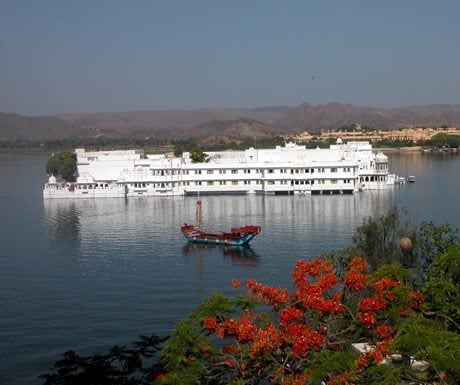 You arrive at the Taj Lake Palace by boat, across the still waters of Lake Pichola. Stepping onto the hotels jetty, you are greeted with a shower of rose petals. A series of courtyards leads past manicured gardens, ornate pillars and so much polished marble that every surface gleams in the sunlight to the centre of the hotel.
The rooms are a catalogue of Indian decorative arts, hand-painted with frescos and decorated with gilded carvings and antique furniture. The impeccably dressed palace butlers are on hand to meet your every whim, such as arranging private dinners by oil lamp or treatments on the private spa boat.
Orange County, Hampi
It may be of modern construction, but the Orange County hotel in Hampi is palatial enough to satisfy a maharaja. The low-rise domes, paved boulevards and arched hallways were inspired by the royal palaces of the Vijayanagara Empire, which ruled large swathes of south India from 1336 to 1565.
You arrive at the Taj Lake Palace by boat, across the still waters of Lake Pichola. Stepping onto the hotels jetty, you are greeted with a shower of rose petals. A series of courtyards leads past manicured gardens, ornate pillars and so much polished marble that every surface gleams in the sunlight to the centre of the hotel.
The rooms are a catalogue of Indian decorative arts, hand-painted with frescos and decorated with gilded carvings and antique furniture. The impeccably dressed palace butlers are on hand to meet your every whim, such as arranging private dinners by oil lamp or treatments on the private spa boat.
Orange County, Hampi
It may be of modern construction, but the Orange County hotel in Hampi is palatial enough to satisfy a maharaja. The low-rise domes, paved boulevards and arched hallways were inspired by the royal palaces of the Vijayanagara Empire, which ruled large swathes of south India from 1336 to 1565.
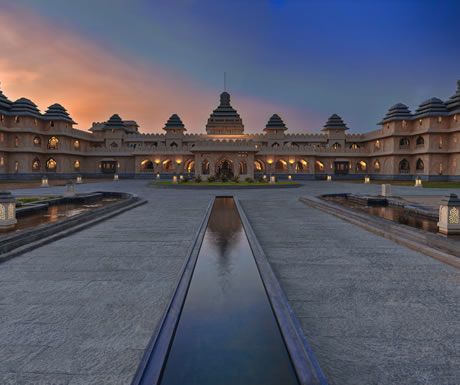 Styled akin to 15th-century royal quarters, the suites sport beamed ceilings, curved balustrades and sumptuous drapery but have the added benefit of modern amenities including a private Jacuzzi.
The UNESCO World Heritage Site of Hampi is a short drive away from the Orange County. Once the largest and wealthiest city in the world, it was the capital of the Vijayanagara Empire argued to have been larger than the Roman Empire. The sprawling remains of the ruined mega city still exist, complete with particularly well-preserved temples and aqueducts.
Sujan Rajmahal Palace, Jaipur
Built as a refuge on the edge of Jaipur, the Sujan Rajmahal Palace has now been engulfed by the spreading city. Originally home to the royal family of Jaipur, it became a British officials residence until Indias independence in 1947 when Maharaja Sawai Man Singh II reclaimed his family home. The royal family have since moved out, but the suites, with names such as the Mountbatten, the Queen Elizabeth II and the Kennedy, celebrate the illustrious guests who were once entertained here.
Styled akin to 15th-century royal quarters, the suites sport beamed ceilings, curved balustrades and sumptuous drapery but have the added benefit of modern amenities including a private Jacuzzi.
The UNESCO World Heritage Site of Hampi is a short drive away from the Orange County. Once the largest and wealthiest city in the world, it was the capital of the Vijayanagara Empire argued to have been larger than the Roman Empire. The sprawling remains of the ruined mega city still exist, complete with particularly well-preserved temples and aqueducts.
Sujan Rajmahal Palace, Jaipur
Built as a refuge on the edge of Jaipur, the Sujan Rajmahal Palace has now been engulfed by the spreading city. Originally home to the royal family of Jaipur, it became a British officials residence until Indias independence in 1947 when Maharaja Sawai Man Singh II reclaimed his family home. The royal family have since moved out, but the suites, with names such as the Mountbatten, the Queen Elizabeth II and the Kennedy, celebrate the illustrious guests who were once entertained here.
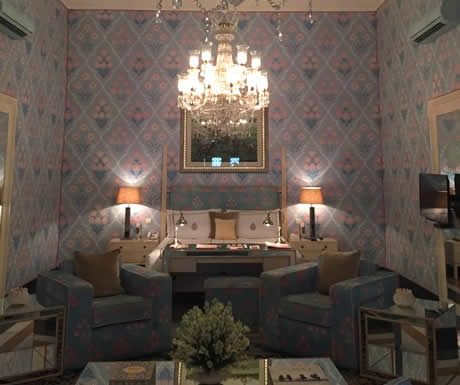 Refurbished by the acclaimed designer Adil Ahmad, each suite is decked in individually designed hand-blocked wallpaper and original art work. Youll find crystal decanters on the sideboard and a chandelier dangling from the ceiling. Some suites reference a classic colonial time, with duck-egg blue fabric and delicate ceiling panels; others celebrate the elite of Indias love of art deco with original furniture and dashes of vibrant fuchsia.
Taj Mahal Palace, Mumbai
In the family of Indian heritage hotels, the Taj Mahal Palace is a baby, opening its doors in 1903. Despite its relative youth, it quickly became an important landmark, overseeing Mumbais glittering social scene. It may not have been built for a royal family, but the walls betray a rich heritage of glitterati, hung with portraits of previous guests from King George V to the Beatles, Roger Moore and, most recently, Barack Obama.
Refurbished by the acclaimed designer Adil Ahmad, each suite is decked in individually designed hand-blocked wallpaper and original art work. Youll find crystal decanters on the sideboard and a chandelier dangling from the ceiling. Some suites reference a classic colonial time, with duck-egg blue fabric and delicate ceiling panels; others celebrate the elite of Indias love of art deco with original furniture and dashes of vibrant fuchsia.
Taj Mahal Palace, Mumbai
In the family of Indian heritage hotels, the Taj Mahal Palace is a baby, opening its doors in 1903. Despite its relative youth, it quickly became an important landmark, overseeing Mumbais glittering social scene. It may not have been built for a royal family, but the walls betray a rich heritage of glitterati, hung with portraits of previous guests from King George V to the Beatles, Roger Moore and, most recently, Barack Obama.
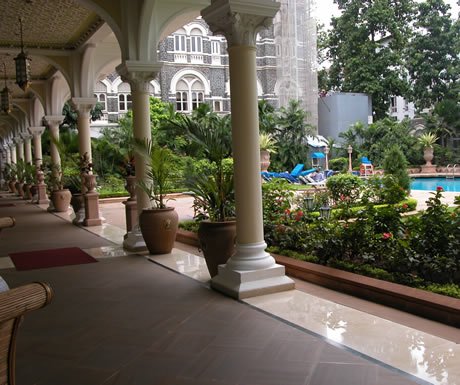 The first Indian hotel to be fitted with electricity and lifts, the Taj Mahal Palace has led the way in impeccable service and facilities ever since. Today, there is, on average, one member of staff to every guest. A private jet is available at four hours notice and the hotels yacht can be booked for parties or a casual private dinner. Still developing new ways to please guests, the hotel has recently added a teen concierge team to assist younger visitors.
RAAS Devigarh, near Udaipur
The towering walls that separate RAAS Devigarh from the sleepy village of Delwara and its neat green fields once protected Indian royalty. Left to ruin, an enterprising family painstakingly restored the 18th-century fortified palace over a 15 year period, turning it into the luxury hotel it is today. On arrival, guests are proudly shown photograph albums documenting the conservation work.
The first Indian hotel to be fitted with electricity and lifts, the Taj Mahal Palace has led the way in impeccable service and facilities ever since. Today, there is, on average, one member of staff to every guest. A private jet is available at four hours notice and the hotels yacht can be booked for parties or a casual private dinner. Still developing new ways to please guests, the hotel has recently added a teen concierge team to assist younger visitors.
RAAS Devigarh, near Udaipur
The towering walls that separate RAAS Devigarh from the sleepy village of Delwara and its neat green fields once protected Indian royalty. Left to ruin, an enterprising family painstakingly restored the 18th-century fortified palace over a 15 year period, turning it into the luxury hotel it is today. On arrival, guests are proudly shown photograph albums documenting the conservation work.
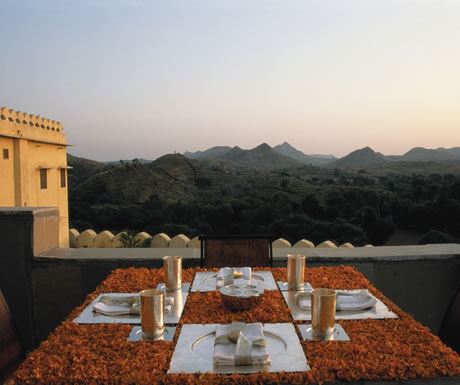 The suites are quietly refined, with clean lines of marble and crisp white linen. The owners, keen to showcase the buildings original palatial features, have kept the design minimal. Choose a palace suite and youll stay in one of the original royal chambers. For the full royal experience, dine in the Sheesh Mahal, the private dining room of Devigarhs kings. Seating only four, this intimate dining room is decorated with hand-painted mirrors and softly lit with candles.
Taj Umaid Bhawan, Jodhpur
The last palace built in India before its independence in 1947 this ginormous golden-yellow palace is one of the largest private residences in the world. Built to provide jobs for a struggling, famine-riddled city, the buildings enormous central dome can be seen right across Jodhpur its viewed by locals as a proud monument to their ancestors who built it. The royal family of Jodhpur still live here, although rarely seen in their private wing although the small on-site museum provides a tantalising glimpse.
The suites are quietly refined, with clean lines of marble and crisp white linen. The owners, keen to showcase the buildings original palatial features, have kept the design minimal. Choose a palace suite and youll stay in one of the original royal chambers. For the full royal experience, dine in the Sheesh Mahal, the private dining room of Devigarhs kings. Seating only four, this intimate dining room is decorated with hand-painted mirrors and softly lit with candles.
Taj Umaid Bhawan, Jodhpur
The last palace built in India before its independence in 1947 this ginormous golden-yellow palace is one of the largest private residences in the world. Built to provide jobs for a struggling, famine-riddled city, the buildings enormous central dome can be seen right across Jodhpur its viewed by locals as a proud monument to their ancestors who built it. The royal family of Jodhpur still live here, although rarely seen in their private wing although the small on-site museum provides a tantalising glimpse.
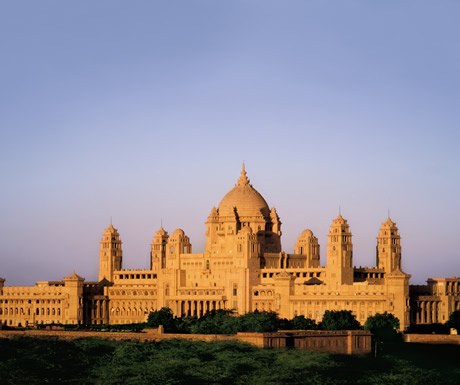 The rest of the palace is now run on an opulent scale: few other hotels can boast stairs made from the same marble as the Taj Mahal. A maze of banqueting halls, ballrooms and throne chambers are connected by echoing hallways, leading to richly furnished suites. Built during the peak of 20s art deco design, the Maharani Suite is a time capsule of original chrome furniture and curved mirrors. The influence of colonial rule is evident just by the spa, where youll find a pair of unique marble-inlay squash courts.
Taj Falaknuma Palace, Hyderabad
If Taj Falaknuma Palace looks a little familiar its because one façades design was based on the White House, the opposite on Buckingham Palace. The resulting building is an imposing collection of pillars, balustrades and 18 types of marble. Perched 600 m (2,000 ft) above the south Indian city of Hyderabad, the palace was once owned by the Nizam (the sovereign of Hyderabad State) and used as the royal guest house. Rumour dictates that Princess Esra, the first wife of the last Nizam, demanded the palace be re-painted more than 100 times until it perfectly matched the colour of the sky at dusk.
The rest of the palace is now run on an opulent scale: few other hotels can boast stairs made from the same marble as the Taj Mahal. A maze of banqueting halls, ballrooms and throne chambers are connected by echoing hallways, leading to richly furnished suites. Built during the peak of 20s art deco design, the Maharani Suite is a time capsule of original chrome furniture and curved mirrors. The influence of colonial rule is evident just by the spa, where youll find a pair of unique marble-inlay squash courts.
Taj Falaknuma Palace, Hyderabad
If Taj Falaknuma Palace looks a little familiar its because one façades design was based on the White House, the opposite on Buckingham Palace. The resulting building is an imposing collection of pillars, balustrades and 18 types of marble. Perched 600 m (2,000 ft) above the south Indian city of Hyderabad, the palace was once owned by the Nizam (the sovereign of Hyderabad State) and used as the royal guest house. Rumour dictates that Princess Esra, the first wife of the last Nizam, demanded the palace be re-painted more than 100 times until it perfectly matched the colour of the sky at dusk.
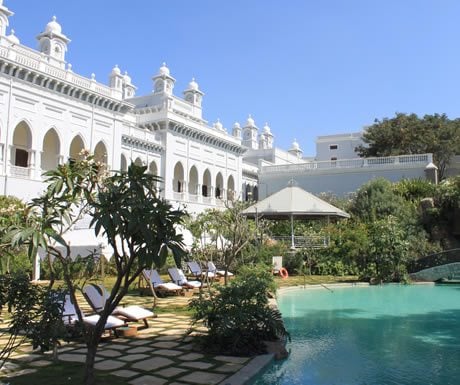 The interiors reflect the palaces 19th-century fashions with delicate murals, indoor marble fountains and the largest collection of Venetian chandeliers in the world. Arrival is by horse and carriage, before you are whisked up the grand staircase to one of the well-appointed suites. Theres a resident historian on hand to give a guided tour, which delves deeper into the complex history of the hotel.
Oberoi Grand, Calcutta
Though not strictly speaking a palace, the Oberoi Grand in Calcutta has the grandeur and history to rival the most regal of structures. Built in a neoclassical design to resemble a palatial villa, it began life as the private residence of a British colonel, Col. Grand. Stints as an exclusive boarding school then a theatre followed, before the building was purchased by Mohan Sing Oberoi to add to his growing empire of luxurious Indian hotels. Hosting extravagant parties and balls, it became popular with British colonialists.
The interiors reflect the palaces 19th-century fashions with delicate murals, indoor marble fountains and the largest collection of Venetian chandeliers in the world. Arrival is by horse and carriage, before you are whisked up the grand staircase to one of the well-appointed suites. Theres a resident historian on hand to give a guided tour, which delves deeper into the complex history of the hotel.
Oberoi Grand, Calcutta
Though not strictly speaking a palace, the Oberoi Grand in Calcutta has the grandeur and history to rival the most regal of structures. Built in a neoclassical design to resemble a palatial villa, it began life as the private residence of a British colonel, Col. Grand. Stints as an exclusive boarding school then a theatre followed, before the building was purchased by Mohan Sing Oberoi to add to his growing empire of luxurious Indian hotels. Hosting extravagant parties and balls, it became popular with British colonialists.
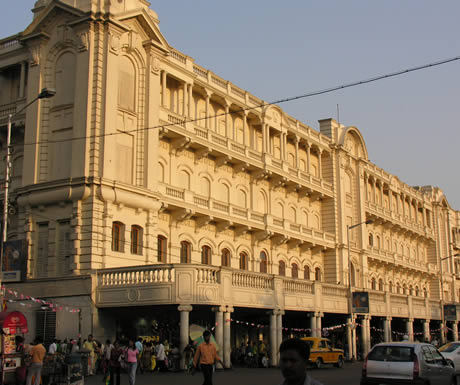 The colonnaded verandas and stucco ornamentation make the building easy to spot from the streets of Calcutta. Right in the heart of the city, the hotel is surrounded by local restaurants, shops and streets crammed with market stalls. Step through the lacquered gates and youll enter a gleaming lobby, which leads to a central courtyard sheltering the pool and terrace. Rooms retain a colonial essence with polished wooden furniture and cream brocade curtains.
Craig Burkinshaw is Founder of Audley Travel.
If you would like to be a guest blogger on A Luxury Travel Blog in order to raise your profile, please contact us.
The colonnaded verandas and stucco ornamentation make the building easy to spot from the streets of Calcutta. Right in the heart of the city, the hotel is surrounded by local restaurants, shops and streets crammed with market stalls. Step through the lacquered gates and youll enter a gleaming lobby, which leads to a central courtyard sheltering the pool and terrace. Rooms retain a colonial essence with polished wooden furniture and cream brocade curtains.
Craig Burkinshaw is Founder of Audley Travel.
If you would like to be a guest blogger on A Luxury Travel Blog in order to raise your profile, please contact us.Did you enjoy this article?
Receive similar content direct to your inbox.


Nice article, a couple more that probably didn’t make the cut are Sardar Samand Palace in Pali, built by the Maharajas of the 1930s. Gajner Palace, Bikaner located in the That desert, the definitive oasis in the desert. And finally Neemrana Palace in Alwar, although not the best hotel in the overall list, what sets this apart from others is its location and overall ‘look’ of the palace.
Hmm, I hate to pick holes in your article but one of India’s greatest leaders, Gandhi, was rather more fond of a mud hut. One could argue that he was not strictly a voted leader of the country I suppose?
Soon, The Laxmi Vilas Palace in Gujarat, India is going to be turned into Hotel. Next Time do visit that also, It’s mesmerizing and is four times the size of Buckingham Palace